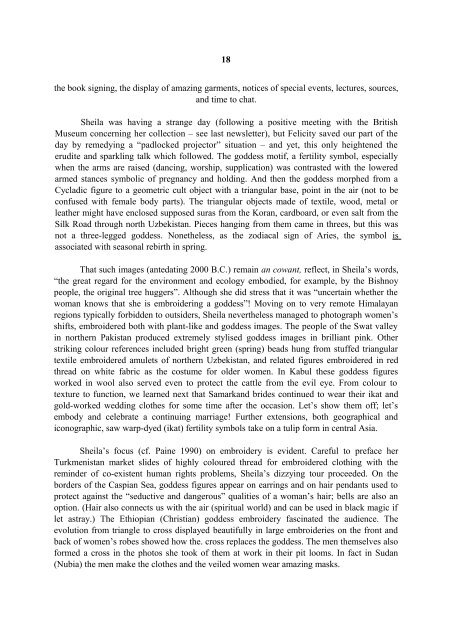download - OATG. Oxford Asian Textile Group
download - OATG. Oxford Asian Textile Group
download - OATG. Oxford Asian Textile Group
You also want an ePaper? Increase the reach of your titles
YUMPU automatically turns print PDFs into web optimized ePapers that Google loves.
18<br />
the book signing, the display of amazing garments, notices of special events, lectures, sources,<br />
and time to chat.<br />
Sheila was having a strange day (following a positive meeting with the British<br />
Museum concerning her collection – see last newsletter), but Felicity saved our part of the<br />
day by remedying a “padlocked projector” situation – and yet, this only heightened the<br />
erudite and sparkling talk which followed. The goddess motif, a fertility symbol, especially<br />
when the arms are raised (dancing, worship, supplication) was contrasted with the lowered<br />
armed stances symbolic of pregnancy and holding. And then the goddess morphed from a<br />
Cycladic figure to a geometric cult object with a triangular base, point in the air (not to be<br />
confused with female body parts). The triangular objects made of textile, wood, metal or<br />
leather might have enclosed supposed suras from the Koran, cardboard, or even salt from the<br />
Silk Road through north Uzbekistan. Pieces hanging from them came in threes, but this was<br />
not a three-legged goddess. Nonetheless, as the zodiacal sign of Aries, the symbol is<br />
associated with seasonal rebirth in spring.<br />
That such images (antedating 2000 B.C.) remain an cowant, reflect, in Sheila’s words,<br />
“the great regard for the environment and ecology embodied, for example, by the Bishnoy<br />
people, the original tree huggers”. Although she did stress that it was “uncertain whether the<br />
woman knows that she is embroidering a goddess”! Moving on to very remote Himalayan<br />
regions typically forbidden to outsiders, Sheila nevertheless managed to photograph women’s<br />
shifts, embroidered both with plant-like and goddess images. The people of the Swat valley<br />
in northern Pakistan produced extremely stylised goddess images in brilliant pink. Other<br />
striking colour references included bright green (spring) beads hung from stuffed triangular<br />
textile embroidered amulets of northern Uzbekistan, and related figures embroidered in red<br />
thread on white fabric as the costume for older women. In Kabul these goddess figures<br />
worked in wool also served even to protect the cattle from the evil eye. From colour to<br />
texture to function, we learned next that Samarkand brides continued to wear their ikat and<br />
gold-worked wedding clothes for some time after the occasion. Let’s show them off; let’s<br />
embody and celebrate a continuing marriage! Further extensions, both geographical and<br />
iconographic, saw warp-dyed (ikat) fertility symbols take on a tulip form in central Asia.<br />
Sheila’s focus (cf. Paine 1990) on embroidery is evident. Careful to preface her<br />
Turkmenistan market slides of highly coloured thread for embroidered clothing with the<br />
reminder of co-existent human rights problems, Sheila’s dizzying tour proceeded. On the<br />
borders of the Caspian Sea, goddess figures appear on earrings and on hair pendants used to<br />
protect against the “seductive and dangerous” qualities of a woman’s hair; bells are also an<br />
option. (Hair also connects us with the air (spiritual world) and can be used in black magic if<br />
let astray.) The Ethiopian (Christian) goddess embroidery fascinated the audience. The<br />
evolution from triangle to cross displayed beautifully in large embroideries on the front and<br />
back of women’s robes showed how the. cross replaces the goddess. The men themselves also<br />
formed a cross in the photos she took of them at work in their pit looms. In fact in Sudan<br />
(Nubia) the men make the clothes and the veiled women wear amazing masks.
















